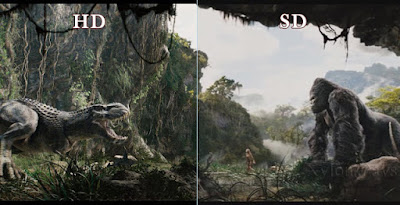TASK 3 - Be able to edit moving image material
"Media Composer is the most proven video editing software in the industry, trusted by professional editors in every segment of movie making, television, broadcast, and streaming media. Designed to handle high volumes of disparate file-based media, Media Composer delivers accelerated high-res and HD workflows, real-time collaboration, and powerful media management, eliminating time-consuming tasks so you can focus on telling a great story. And now the choice is yours—edit on premises, or remotely through the cloud—access through a low-cost subscription, on-demand via floating license, or own it outright—making Media Composer the most versatile and accessible tool for professional creative editorial. " - Avid
Although there are many different editing softwares we use Avid, as its the best and near professional standard.
Standard and High Definition.
Most pieces of film or television are exported in high-definition now, however, standard-definition is still active in digital technology. High-definition has a higher resolution than standard-definition, which is why it is used more and appreciated more aesthetically. Below is a photo demonstrating the difference between the two :

Hard discs are used rather commonly in the film and television industry, as blank hard disc usually very affordable, that and they work quite efficiently. An example of hard discs being used in the film and television industry includes; An editor using hard discs to store footage that they can later use to import the footage onto their editing software. At the end of both music video and advert we had to upload our work onto a hard disk in order for it to be viewed.
Data Transfer Rates is the amount of digital data that is transferred from one location to another in a given time. Digital data that is common in the film and television industry can include video and audio files.
Exporting is usually simple to do, as you normally just name your file and select the settings that are most appropriate for your piece of work. The only downfall about exporting productions is that is can be very time-consuming, the time in which it will take is usually stated at the bottom. Before exporting you need to have rendered the finished product.
Jump-Cutting in Avid is fairly simple, as all that the editor has to do is cut a piece of footage in half. This can easily be done by selecting an input (I on keyboard) and output (O on keyboard) and either pressing Z or X on the keyboard. This can tell the audience that time has jumped/leaped forward.
There are many transitions that are available to the editor in 'Avid Media Composer'. Examples of transition effects that are included in 'Avid Media Composer' include; dissolve, fade, picture-in-picture and 3D Warp. These effects are easy to locate and learn.
Sound and visual syncing is one of the most important and necessary things that is vital to understand when it comes to editing for the moving image. You cannot have moving image where the sound and the visuals do not match up, as it looks unprofessional.
On screen text is used mainly when the editor is adding credits and titles to a piece of moving image. This post-production tool is fairly straight forward to do in Avid Media Composer.






